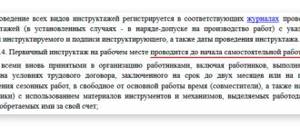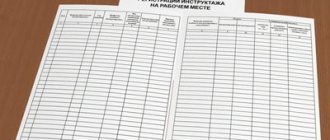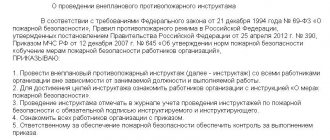Why do you need instruction?
In almost any workplace, an employee may encounter factors that pose a danger to his health or a threat to the safety of property provided to him by the employer.
In emergency situations, there may be a danger to the life of an employee. To reduce the negative impact of production factors and the likelihood of dangerous situations occurring, each employee is familiarized with safety rules in the workplace. As a result, he gets an idea of:
- the nature of the enterprise’s activities, the role of its workplace, equipment and materials used in it;
- factors that may pose danger or harm at this location;
- rules of behavior on the employer’s territory and a specific workplace;
- principles of safe operation on existing equipment;
- the procedure for preparing the workplace for work and the rules for its completion;
- use of personal protective equipment;
- measures to prevent fires and accidents;
- behavior in case of danger or accident;
- methods of providing first aid to victims.
For information about what factors may pose danger or harm, read the article “Dangerous and harmful production factors (list).”
It is assumed that as a result of the training, the employee acquires all the necessary knowledge about the rules of conduct in the workplace and becomes responsible for the consequences of violating these rules. Since compliance with safety regulations is one of the duties of an employee (Article 214 of the Labor Code of the Russian Federation) and relates to labor discipline (Article 189 of the Labor Code of the Russian Federation), for its violation he can be punished by the employer by issuing a reprimand or reprimand, and if there is intent in the actions , creating a threat or causing serious consequences - dismissed (Article 192 of the Labor Code of the Russian Federation).
If failure to comply with safety regulations led to material losses for the employer, then at the same time as disciplinary action, the employee can be held financially liable (Article 248 of the Labor Code of the Russian Federation). And in cases of serious consequences for the health or life of people, criminal liability is possible under Art. 143, 216, 217, 219 of the Criminal Code of the Russian Federation, which, depending on the severity of these consequences, varies from a fine to imprisonment.
Design features
The need for registration arises in several situations:
- when expanding an enterprise or opening new branches and recruiting an additional number of workers;
- with radical changes in the direction of production;
- when changing the terms of contracts that were previously concluded with employees.
Structure
Typically, production instructions include the following sections:
- general information;
- qualification requirements;
- functions and tasks performed in production;
- employee responsibilities;
- rights;
- responsibility for actions taken at work.
Note! This construction also applies to job descriptions, the main difference of which lies only in the category of employees. The contents of the act may be supplemented depending on the specifics.
Completing the main sections
The instructions are issued in two variations: as an addition to the contract and as a separate document. Both methods are common in Russia. There are no special differences in filling.
First, fill out the general provisions section. It is based on reference books and Russian legislation. This section is almost identical for all professions and has minimal differences.
When filling out the qualification requirements, the following are taken into account:
- employee responsibilities;
- the employee’s knowledge of the goals and objectives of the work, as well as ways to achieve them;
- the level of education.
For a clearer presentation of the rules and regulations, analysts are brought in to help.
You need to pay special attention to the section of the instructions called “Production Functions”. This is where the rules that govern actions to solve a specific problem are described. It is at this point that the instructions for different professions differ as much as possible. This may be caused by different equipment (for example, the operating principles of a crane and a boiler room are completely opposite) or different required labor results, for example, for a slinger and an electric gas welder. Their responsibilities will also be different.
Note! The sections on rights and responsibilities have universal wording that applies to most professions.
Additional sections
In addition to the main sections, you can include additional points in the instructions regarding:
- cash bonuses for special labor achievements;
- taking special precautions;
- additional conditions for the implementation of the labor process.
Types and organization of instruction
Safety training at the workplace can be:
- introductory, dedicated to the general rules of safe behavior;
- primary, giving the employee the most complete understanding of all aspects of safe work and the procedure for action in case of dangerous situations, without which the employee is not allowed to work;
- repeated, carried out every six months with the aim of periodically repeating the information received during the initial briefing;
- unscheduled, the need for which arises in dangerous situations;
- targeted, when new equipment or technologies appear that require additional rules of conduct when working with them, or new requirements for safe behavior.
Introductory briefing can be carried out separately by a labor protection engineer, or can be combined with the initial one. Primary and all other types of instruction are carried out by the employee’s immediate supervisor, who has undergone special training for this purpose. Instruction can be either individual or group.
All employees are subject to the initial briefing procedure:
- newly hired;
- transferred to a new location;
- hired temporarily: temporary (seasonal) workers, business travelers, trainees;
- part-time workers and homeworkers.
By decision of the employer, employees in certain positions that do not require the use of technical devices may be exempt from initial training.
Initial, repeated and unscheduled briefings for employees occupying the same positions are carried out according to the same program developed by the employer specifically for them. Accordingly, the program may be different for other positions. That is, one employer may have several training programs.
You can find ready-made samples of training programs for various specialties, jobs, positions in ConsultantPlus. Get free trial access and proceed, for example, to a sample loading and unloading training program. Or find a sample that is needed specifically for your specific activity.
At the end of the briefing, the employee is introduced to the safety instructions and his knowledge is tested.
Read more about the procedure for conducting the briefing in the article “How to conduct a safety briefing (nuances)?”
Who develops, coordinates and approves labor safety instructions
Before being allowed to work independently, workers must be familiarized with the labor safety instructions and tested for knowledge of safe techniques and work performance skills. This is the task of every immediate manager.
At the same time, monitoring the conduct of briefings and providing methodological assistance in developing instructions is the responsibility of a labor protection specialist .
The help of an occupational safety specialist consists of checking the correct application of regulatory legal acts, but safety measures for department heads and immediate supervisors need to be gleaned from the operating manual and labor protection rules.
Note! Article 212 of the Labor Code of the Russian Federation directly states that the employer coordinates draft rules and instructions on occupational safety with a representative body of employees, for example, a trade union.
Thus, approval of the instruction and its entry into force is impossible without the agreement of employee representatives. If such a body has not been created in the organization, it is necessary to create it if there is such an initiative. The initiative, we remind you, can come not only from the employees themselves, but also from conscious employers.
The role of the OT service is to provide methodological assistance, and then to monitor the correct application of the legislation and the training itself.
At many enterprises, instructions are drawn up by an occupational safety specialist, and then transferred to the department for signatures. This is incorrect and contradicts not only the Procedure for training and testing knowledge of labor protection requirements No. 1/29 of 01/13/2003, but also the regulations on the occupational safety and health system developed and approved at each enterprise (section - distribution of responsibilities of labor protection officials).
Alternatively, the safety specialist, together with the immediate supervisor in the department, develop instructions together, but only if the enterprise and the developer have no idea how to draw up this document.
After the department has prepared a draft instruction, a labor protection specialist reviews it, makes his comments or additions, and returns it to the developer for revision.
After this, once the instructions are corrected and the occupational safety specialist confirms this with his signature in the approval field, the instructions are submitted to the trade union committee for approval. Then, after the draft instructions are marked for approval, the project must be submitted for inclusion in the order for approval by the head of the organization.
Note! How to familiarize an employee with the occupational safety instructions must be indicated either in the training regulations, or in the regulations on the occupational safety management system, or in the order itself to put the instructions into effect.
As a rule, employees sign the introductory sheet for the instructions. It is recommended to create separate journals for issuing instructions on labor protection, but not prescribed in regulatory legal acts.
Workplace safety instructions
The workplace safety instructions in printed form contain all the information that the employee is introduced to orally and by demonstrating work methods and actions during the instruction.
Accordingly, one instruction can be used for the same (or similar) jobs. Other places should have their own document similar in content.
Upon completion of the briefing, the employee is given the text of the instructions relating to his position for review.
Safety precautions: basic concepts
Occupational safety instructions for technicians, road workers and other workers are an internal document that defines the specific responsibilities of workers and prescribed safety requirements.
Basic safety rules
In 2021, several types of guidelines have been established, including:
- by specialization and position. For example, specially developed internal instructions for the security department or for the cook;
- with the rules of conduct of personnel in the event of an emergency, this is relevant if any test is being carried out;
- setting up new mechanisms and other production equipment, repairs in explosive areas, or for employees to prevent terrorist acts, emergency workers (in the event of a fire or other emergency) performing specific work at height, for office specialists (any office must have appropriate instructions that meets the requirements of GOST).
Compliance with developed and approved regulations is a mandatory condition for everyone, and ignoring them entails a violation of labor discipline.
Conducting briefing
Important! The document may include rules for conducting training if necessary.
Briefing log
The fact of conducting a briefing, regardless of its type, is recorded in a special journal, which reflects:
- data of the instructed employee;
- type of training provided;
- details of the instructions according to which the briefing was carried out;
- date of the briefing;
- instructor details;
- 2 signatures: employee and instructor.
An example of filling out a workplace briefing log, compiled in accordance with GOST, was prepared by ConsultantPlus experts. Get free access to the system and proceed to the sample.
How is it different from a job description?
In relation to the work process, the job description only regulates WHAT the employee must do.
And the work instructions indicate HOW to do this.
In addition, a job description is usually a formal document that is created only to fulfill a legal requirement. The job description is not used in permanent work.
And the work instructions are like a recipe - you need to follow the steps indicated in it and achieve the required result.
Results
Conducting safety training is extremely important as a measure to prevent the creation of situations in the workplace that pose a danger to the health of workers and the safety of the employer’s property.
It is carried out in compliance with certain requirements to ensure that the employee is ready to comply with established rules of behavior that meet the requirements of safe work.
Sources: Labor Code of the Russian Federation
You can find more complete information on the topic in ConsultantPlus. Free trial access to the system for 2 days.
What sections should be in the TB instructions?
Health and Safety Inspector
Instructions for occupational safety in preschool institutions or drivers while a vehicle is moving, sanitary workers and other workers should include the following typical sections:
- general explanations;
- occupational safety requirements directly during the execution of work, for example, maintenance of energy systems (rules for working in the contact group of high-voltage networks);
- primary actions in case of an accident and other emergencies;
- occupational safety requirements upon completion of work for a particular category of workers, for example, a specialist in the manufacture of workpieces or a group.
Important! The company's management reserves the full right to supplement the typical instructions if necessary, if this does not contradict the rules of federal law.
HOW TO WRITE A WORKING INSTRUCTION: 7 RULES
The work instructions should be similar to a step-by-step guide: do it once, do two, do three.
Work instructions should clearly explain how employees perform their tasks. There is no room for interpretation. They shouldn't be vague. With work instructions, you want to minimize the chance of them confusing your employees. This means keeping your instructions as short and simple as possible.
The Internet is replete with amusing examples of poorly written instructions and others with amusing double meanings. Below we present 6 rules by which Active Sales Group specialists develop work instructions for projects to strengthen management systems:
► Rule #1 - CLARITY
The employee reads the work instructions and immediately understands the meaning. Avoid polysyllabic words, complex sentences, jargon, acronyms, and too many technical terms (without explaining them).
Write work instructions so that they can be easily understood by each employee performing the task. Even for a beginner.
Use simple sentence structures: noun (subject) - verb (predicate) - modifier (adjective) - noun (object) - noun (adverbial adverbial).
Example: “The manager (subject) uses (predicate) received (definition) data (addition) to generate a request for calculation (addition).”
Important: avoid adverbial and participial phrases! Always use "which" instead.
Use numbered lists and hierarchical lists to clearly communicate the meaning of instructions.
► Rule No. 2 - AVAILABILITY
If your regulations and instructions are located on a network drive, but you have transferred the department to remote work, do not forget to provide employees with quick access to documents.
Remember that it is not only office employees who need to manage the quality of work. Sales representatives, warehouse and production workers, and salespeople at the point of sale should have easy access to work instructions.
► Rule No. 3 - RELIABILITY
Employees should consider work instructions to be true, useful and accurate. Otherwise it's just another good idea that no one cares about. Consult with the most experienced person performing the task and ask him to explain how the job is done. Make sure your instructions are correct.
► Rule #4 - CONSISTENCY
Work instructions must follow a uniform style. Consistency in terminology, style and methods of presentation makes them easier to study and assimilate. They also need to be relevant to employees' existing skills in terms of consistency and relevance.
► Rule No. 5 - BRIEFS AND CLARITY
Work instructions are always concise and clear. Write as briefly and clearly as possible.
If you can't explain it to your subordinates in a simple way, then you don't understand it well enough! Take time to understand this completely. This will avoid mistakes in the future.
Writing a work instruction is not about looking smart. Your text should be understandable to both veterans and newcomers. Try to make it as short and simple as possible.
► Rule No. 6 - VISUALITY
We live in a visual world. 90% of people perceive information visually. To meet this need, use images, drawings, and videos in your work instructions. Consider who will be using your work instructions and try to prepare them accordingly.
► Rule No. 7 - EXPERT
The work instructions should be written by a person who has experience in performing the task. Do not delegate the task of writing work instructions to someone who is not 100% familiar with the work.
Assign the writing of work instructions to department heads. By writing instructions, they will become more aware of the problems in their production process and will be able to correct them.
WORKING INSTRUCTIONS, REGULATIONS AND PROCESS: WHAT ARE THE DIFFERENCES
The term “work instructions” is inextricably linked with the term “work regulations” .
A regulation is a document that regulates a business process. Thus, all three concepts - process, regulations and instructions - are interrelated. These terms are used in modern management for managing organizational processes - Business Process Management (BPM) .
Many managers often confuse these three terms. Most managers write work instructions and call them regulations (in English terminology, regulations are called procedures) or define regulations as a process.
► What is a Business Process?
The ISO 9001 (Quality Management Systems) standard defines the concept of a Business Process as “A set of related or interacting activities that transform inputs into outputs.”
You can clarify: a process is a sequence of actions with an order of implementation in time, which transforms given input data into an output (result, product).
Any activity or set of activities that uses resources to transform input elements into outputs can be considered a process.
Business processes are modeled based on the business process model standard and BPMN ( Business Process Management Notation ) notation.
The business process model is visually presented in the form of a flowchart:
Process Flowchart in BPMN Notation
Don't confuse regulations with process.
► What are the Regulations?
The ISO 9001 standard states that a Regulation is “A specified way of performing an activity or process.” If you have a process that needs to happen in a certain way, and you specify how it happens, then you have developed a Regulation.
The regulation is mandatory for the development of any quality management system.
It is important that not all processes need to have regulations. And that the same process may be associated with one or more regulations.
The regulation will be determined by the need to detail the specific way in which process activities are performed, taking into account legal issues, regulatory compliance, execution methods and techniques, or company policies.
Regulations are used for those activities that involve several operations and involve different people or departments of the company (for example, Procurement Regulations, Supplier Evaluation Regulations, Customer Attraction Regulations, Invoice Automation Regulations, etc.).
Work instructions, regulations and process
► What is a Work Instruction?
Work instructions are documents that clearly and accurately describe the correct way to perform specific tasks.
Work instructions are often required to describe how to perform complex tasks. Those that require the use of different tools, different knowledge, and also if the employee’s actions can cause inconvenience or damage if they are not performed in the established order.
That is, a work instruction describes, dictates, or stipulates the steps that must be followed to properly perform any specific action or job.
For example, “Instructions for providing a discount”, “Instructions for calculating the cost of the project”, “Instructions for registering a business trip”, etc.
Work instructions mainly focus on explaining how a particular job will be performed. The work instructions are mandatory . If it is not mandatory, it will be a Work Guide.








